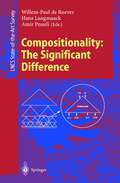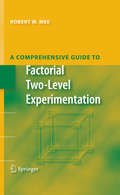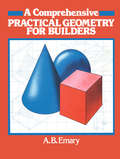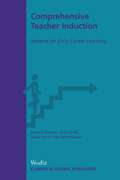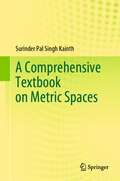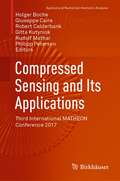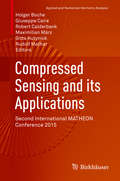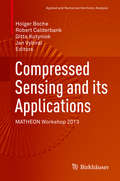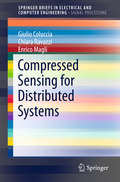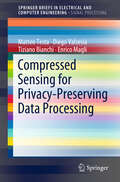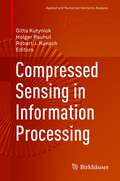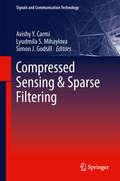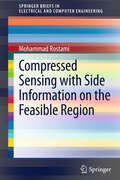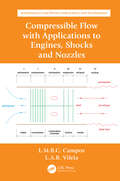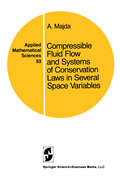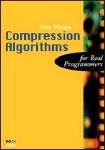- Table View
- List View
Compositionality: International Symposium, COMPOS’97 Bad Malente, Germany, September 8–12, 1997 Revised Lectures (Lecture Notes in Computer Science #1536)
by Willem-Paul De Roever Hans Langmaack Amir PnueliThis book originates from the International Symposium on Compositionality, COMPOS'97, held in Bad Malente, Germany in September 1997. The 25 chapters presented in revised full version reflect the current state of the art in the area of compositional reasoning about concurrency. The book is a valuable reference for researchers and professionals interested in formal systems design and analysis; it also is well suited for self study and use in advanced courses.
Comprehensive Applied Mathematical Modeling in the Natural and Engineering Sciences: Theoretical Predictions Compared with Data
by David J. Wollkind Bonni J. DichoneThis text demonstrates the process of comprehensive applied mathematical modeling through the introduction of various case studies. The case studies are arranged in increasing order of complexity based on the mathematical methods required to analyze the models. The development of these methods is also included, providing a self-contained presentation. To reinforce and supplement the material introduced, original problem sets are offered involving case studies closely related to the ones presented. With this style, the text’s perspective, scope, and completeness of the subject matter are considered unique. Having grown out of four self-contained courses taught by the authors, this text will be of use in a two-semester sequence for advanced undergraduate and beginning graduate students, requiring rudimentary knowledge of advanced calculus and differential equations, along with a basic understanding of some simple physical and biological scientific principles.
A Comprehensive Guide to Factorial Two-Level Experimentation
by Robert MeeThis book contains the most comprehensive coverage available anywhere for two-level factorial designs. The re-analysis of 50 published examples serves as a how-to guide for analysis of the many types of full factorial and fractional factorial designs. By focusing on two-level designs, this book is accessible to a wide audience of practitioners who use planned experiments.
Comprehensive Mathematics for Computer Scientists 1: Sets and Numbers, Graphs and Algebra, Logic and Machines, Linear Geometry (Universitext)
by Guerino Mazzola Gérard Milmeister Jody WeissmannContains all the mathematics that computer scientists need to know in one place.
Comprehensive Mathematics for Computer Scientists 2: Calculus and ODEs, Splines, Probability, Fourier and Wavelet Theory, Fractals and Neural Networks, Categories and Lambda Calculus (Universitext)
by Guerino Mazzola Gérard Milmeister Jody WeissmannThis second volume of a comprehensive tour through mathematical core subjects for computer scientists completes the ?rst volume in two - gards: Part III ?rst adds topology, di?erential, and integral calculus to the t- ics of sets, graphs, algebra, formal logic, machines, and linear geometry, of volume 1. With this spectrum of fundamentals in mathematical e- cation, young professionals should be able to successfully attack more involved subjects, which may be relevant to the computational sciences. In a second regard, the end of part III and part IV add a selection of more advanced topics. In view of the overwhelming variety of mathematical approaches in the computational sciences, any selection, even the most empirical, requires a methodological justi?cation. Our primary criterion has been the search for harmonization and optimization of thematic - versity and logical coherence. This is why we have, for instance, bundled such seemingly distant subjects as recursive constructions, ordinary d- ferential equations, and fractals under the unifying perspective of c- traction theory.
Comprehensive Teacher Induction: Systems for Early Career Learning
by E.D. Britton L. Paine S. RaizenBased on a three-year study, the authors describe how comprehensive teacher induction systems can both provide teacher support and promote learning more about how to teach. This book calls for re-thinking what teacher induction is about, whom it should serve, what the ‘curriculum’ of induction should be, and the policies, programs, and practices needed to deliver it.
A Comprehensive Textbook of Classical Mathematics: A Contemporary Interpretation
by H.B. Griffiths P.J. Hiltonarithmetic of the integers, linear algebra, an introduction to group theory, the theory of polynomial functions and polynomial equations, and some Boolean algebra. It could be supplemented, of course, by material from other chapters. Again, Course 5 (Calculus) aiscusses the differential and integral calculus more or less from the beginnings of these theories, and proceeds through functions of several real variables, functions of a complex variable, and topics of real analysis such as the implicit function theorem. We would, however, like to make a further point with regard to the appropriateness of our text in course work. We emphasized in the Introduction to the original edition that, in the main, we had in mind the reader who had already met the topics once and wished to review them in the light of his (or her) increased knowledge and mathematical maturity. We therefore believe that our book could form a suitable basis for American graduate courses in the mathematical sciences, especially those prerequisites for a Master's degree.
A Comprehensive Textbook on Metric Spaces
by Surinder Pal KainthThis textbook provides a comprehensive course in metric spaces. Presenting a smooth takeoff from basic real analysis to metric spaces, every chapter of the book presents a single concept, which is further unfolded and elaborated through related sections and subsections. Apart from a unique new presentation and being a comprehensive textbook on metric spaces, it contains some special concepts and new proofs of old results, which are not available in any other book on metric spaces. It has individual chapters on homeomorphisms and the Cantor set. This book is almost self-contained and has an abundance of examples, exercises, references and remarks about the history of basic notions and results. Every chapter of this book includes brief hints and solutions to selected exercises. It is targeted to serve as a textbook for advanced undergraduate and beginning graduate students of mathematics.
A Comprehensive Textbook on Sample Surveys (Indian Statistical Institute Series)
by Arijit Chaudhuri Sanghamitra PalAs a comprehensive textbook in survey sampling, this book discusses the inadequacies of classic, designed-based inferential procedures and provides alternative approaches in the form of model formulations, model-design-based procedures of analysis, inference and interpretation. The book focuses on a wide range of topics which included Bayesian and Empirical Bayesian approaches, complex procedures of stratification, clustering, sampling in multi stages and phases, linear and non-linear estimation of parameters, small area estimation by spatial and chronological modelling, network and adaptive sampling methods and more. The book includes detailed case studies and exercises, making it valuable for students of statistics, specifically survey sampling.
A Comprehensive Treatment of q-Calculus
by Thomas ErnstTo date, the theoretical development of q-calculus has rested on a non-uniform basis. Generally, the bulky Gasper-Rahman notation was used, but the published works on q-calculus looked different depending on where and by whom they were written. This confusion of tongues not only complicated the theoretical development but also contributed to q-calculus remaining a neglected mathematical field. This book overcomes these problems by introducing a new and interesting notation for q-calculus based on logarithms.For instance, q-hypergeometric functions are now visually clear and easy to trace back to their hypergeometric parents. With this new notation it is also easy to see the connection between q-hypergeometric functions and the q-gamma function, something that until now has been overlooked.The book covers many topics on q-calculus, including special functions, combinatorics, and q-difference equations. Apart from a thorough review of the historical development of q-calculus, this book also presents the domains of modern physics for which q-calculus is applicable, such as particle physics and supersymmetry, to name just a few.
Compressed Sensing and Its Applications: Third International MATHEON Conference 2017 (Applied and Numerical Harmonic Analysis)
by Holger Boche Giuseppe Caire Robert Calderbank Gitta Kutyniok Rudolf Mathar Philipp PetersenThe chapters in this volume highlight the state-of-the-art of compressed sensing and are based on talks given at the third international MATHEON conference on the same topic, held from December 4-8, 2017 at the Technical University in Berlin. In addition to methods in compressed sensing, chapters provide insights into cutting edge applications of deep learning in data science, highlighting the overlapping ideas and methods that connect the fields of compressed sensing and deep learning. Specific topics covered include:Quantized compressed sensingClassificationMachine learningOracle inequalitiesNon-convex optimizationImage reconstructionStatistical learning theoryThis volume will be a valuable resource for graduate students and researchers in the areas of mathematics, computer science, and engineering, as well as other applied scientists exploring potential applications of compressed sensing.
Compressed Sensing and its Applications: Second International MATHEON Conference 2015 (Applied and Numerical Harmonic Analysis)
by Holger Boche Giuseppe Caire Robert Calderbank Maximilian März Gitta Kutyniok Rudolf MatharThis contributed volume contains articles written by the plenary and invited speakers from the second international MATHEON Workshop 2015 that focus on applications of compressed sensing. Article authors address their techniques for solving the problems of compressed sensing, as well as connections to related areas like detecting community-like structures in graphs, curbatures on Grassmanians, and randomized tensor train singular value decompositions. Some of the novel applications covered include dimensionality reduction, information theory, random matrices, sparse approximation, and sparse recovery. This book is aimed at both graduate students and researchers in the areas of applied mathematics, computer science, and engineering, as well as other applied scientists exploring the potential applications for the novel methodology of compressed sensing. An introduction to the subject of compressed sensing is also provided for researchers interested in the field who are not as familiar with it.
Compressed Sensing and its Applications: MATHEON Workshop 2013 (Applied and Numerical Harmonic Analysis)
by Holger Boche Robert Calderbank Gitta Kutyniok Jan VybíralSince publication of the initial papers in 2006, compressed sensing has captured the imagination of the international signal processing community, and the mathematical foundations are nowadays quite well understood.Parallel to the progress in mathematics, the potential applications of compressed sensing have been explored by many international groups of, in particular, engineers and applied mathematicians, achieving very promising advances in various areas such as communication theory, imaging sciences, optics, radar technology, sensor networks, or tomography.Since many applications have reached a mature state, the research center MATHEON in Berlin focusing on "Mathematics for Key Technologies", invited leading researchers on applications of compressed sensing from mathematics, computer science, and engineering to the "MATHEON Workshop 2013: Compressed Sensing and its Applications” in December 2013. It was the first workshop specifically focusing on the applications of compressed sensing. This book features contributions by the plenary and invited speakers of this workshop. To make this book accessible for those unfamiliar with compressed sensing, the book will not only contain chapters on various applications of compressed sensing written by plenary and invited speakers, but will also provide a general introduction into compressed sensing.The book is aimed at both graduate students and researchers in the areas of applied mathematics, computer science, and engineering as well as other applied scientists interested in the potential and applications of the novel methodology of compressed sensing. For those readers who are not already familiar with compressed sensing, an introduction to the basics of this theory will be included.
Compressed Sensing for Distributed Systems (SpringerBriefs in Electrical and Computer Engineering)
by Giulio Coluccia Chiara Ravazzi Enrico MagliThis book presents a survey of the state-of-the art in the exciting and timely topic of compressed sensing for distributed systems. It has to be noted that, while compressed sensing has been studied for some time now, its distributed applications are relatively new. Remarkably, such applications are ideally suited to exploit all the benefits that compressed sensing can provide. The objective of this book is to provide the reader with a comprehensive survey of this topic, from the basic concepts to different classes of centralized and distributed reconstruction algorithms, as well as a comparison of these techniques. This book collects different contributions on these aspects. It presents the underlying theory in a complete and unified way for the first time, presenting various signal models and their use cases. It contains a theoretical part collecting latest results in rate-distortion analysis of distributed compressed sensing, as well as practical implementations of algorithms obtaining performance close to the theoretical bounds. It presents and discusses various distributed reconstruction algorithms, summarizing the theoretical reconstruction guarantees and providing a comparative analysis of their performance and complexity. In summary, this book will allow the reader to get started in the field of distributed compressed sensing from theory to practice. We believe that this book can find a broad audience among researchers, scientists, or engineers with very diverse backgrounds, having interests in mathematical optimization, network systems, graph theoretical methods, linear systems, stochastic systems, and randomized algorithms. To help the reader become familiar with the theory and algorithms presented, accompanying software is made available on the authors’ web site, implementing several of the algorithms described in the book. The only background required of the reader is a good knowledge of advanced calculus and linear algebra.
Compressed Sensing for Privacy-Preserving Data Processing (SpringerBriefs in Electrical and Computer Engineering)
by Matteo Testa Diego Valsesia Tiziano Bianchi Enrico MagliThe objective of this book is to provide the reader with a comprehensive survey of the topic compressed sensing in information retrieval and signal detection with privacy preserving functionality without compromising the performance of the embedding in terms of accuracy or computational efficiency. The reader is guided in exploring the topic by first establishing a shared knowledge about compressed sensing and how it is used nowadays. Then, clear models and definitions for its use as a cryptosystem and a privacy-preserving embedding are laid down, before tackling state-of-the-art results for both applications. The reader will conclude the book having learned that the current results in terms of security of compressed techniques allow it to be a very promising solution to many practical problems of interest. The book caters to a broad audience among researchers, scientists, or engineers with very diverse backgrounds, having interests in security, cryptography and privacy in information retrieval systems. Accompanying software is made available on the authors’ website to reproduce the experiments and techniques presented in the book. The only background required to the reader is a good knowledge of linear algebra, probability and information theory.
Compressed Sensing in Information Processing (Applied and Numerical Harmonic Analysis)
by Gitta Kutyniok Holger Rauhut Robert J. KunschThis contributed volume showcases the most significant results obtained from the DFG Priority Program on Compressed Sensing in Information Processing. Topics considered revolve around timely aspects of compressed sensing with a special focus on applications, including compressed sensing-like approaches to deep learning; bilinear compressed sensing - efficiency, structure, and robustness; structured compressive sensing via neural network learning; compressed sensing for massive MIMO; and security of future communication and compressive sensing.
Compressed Sensing & Sparse Filtering (Signals and Communication Technology)
by Avishy Y. Carmi Lyudmila S. Mihaylova Simon J. GodsillThis book is aimed at presenting concepts, methods and algorithms ableto cope with undersampled and limited data. One such trend that recently gained popularity and to some extent revolutionised signal processing is compressed sensing. Compressed sensing builds upon the observation that many signals in nature are nearly sparse (or compressible, as they are normally referred to) in some domain, and consequently they can be reconstructed to within high accuracy from far fewer observations than traditionally held to be necessary. Apart from compressed sensing this book contains other related approaches. Each methodology has its own formalities for dealing with such problems. As an example, in the Bayesian approach, sparseness promoting priors such as Laplace and Cauchy are normally used for penalising improbable model variables, thus promoting low complexity solutions. Compressed sensing techniques and homotopy-type solutions, such as the LASSO, utilise l1-norm penalties for obtaining sparse solutions using fewer observations than conventionally needed. The book emphasizes on the role of sparsity as a machinery for promoting low complexity representations and likewise its connections to variable selection and dimensionality reduction in various engineering problems. This book is intended for researchers, academics and practitioners with interest in various aspects and applications of sparse signal processing.
Compressed Sensing with Side Information on the Feasible Region (SpringerBriefs in Electrical and Computer Engineering)
by Mohammad RostamiThis book discusses compressive sensing in the presence of side information. Compressive sensing is an emerging technique for efficiently acquiring and reconstructing a signal. Interesting instances of Compressive Sensing (CS) can occur when, apart from sparsity, side information is available about the source signals. The side information can be about the source structure, distribution, etc. Such cases can be viewed as extensions of the classical CS. In these cases we are interested in incorporating the side information to either improve the quality of the source reconstruction or decrease the number of samples required for accurate reconstruction. In this book we assume availability of side information about the feasible region. The main applications investigated are image deblurring for optical imaging, 3D surface reconstruction, and reconstructing spatiotemporally correlated sources. The author shows that the side information can be used to improve the quality of the reconstruction compared to the classic compressive sensing. The book will be of interest to all researchers working on compressive sensing, inverse problems, and image processing.
The Compressed Word Problem for Groups (SpringerBriefs in Mathematics)
by Markus LohreyThe Compressed Word Problem for Groups provides a detailed exposition of known results on the compressed word problem, emphasizing efficient algorithms for the compressed word problem in various groups. The author presents the necessary background along with the most recent results on the compressed word problem to create a cohesive self-contained book accessible to computer scientists as well as mathematicians. Readers will quickly reach the frontier of current research which makes the book especially appealing for students looking for a currently active research topic at the intersection of group theory and computer science. The word problem introduced in 1910 by Max Dehn is one of the most important decision problems in group theory. For many groups, highly efficient algorithms for the word problem exist. In recent years, a new technique based on data compression for providing more efficient algorithms for word problems, has been developed, by representing long words over group generators in a compressed form using a straight-line program. Algorithmic techniques used for manipulating compressed words has shown that the compressed word problem can be solved in polynomial time for a large class of groups such as free groups, graph groups and nilpotent groups. These results have important implications for algorithmic questions related to automorphism groups.
Compressible Flow with Applications to Engines, Shocks and Nozzles (Mathematics and Physics for Science and Technology #11)
by Luis Manuel Braga da Costa Campos Luís António Raio VilelaCompressible Flow with Application to Shocks and Propulsion is part of the series "Mathematics and Physics for Science and Technology", which combines rigorous mathematics with general physical principles to model practical engineering systems with a detailed derivation and interpretation of results. Volume V presents the mathematical theory of partial differential equations and methods of solution satisfying initial and boundary conditions, and includes applications to: acoustic, elastic, water, electromagnetic and other waves; the diffusion of heat, mass and electricity; and their interactions. This is the second book of the volume. The first book of volume V starts with the classification of partial differential equations and proceeds with similarity methods that apply in general to linear equations with constant coefficients and all derivatives of the same order, such as the Laplace and Biharmonic equations, without and with forcing. The similarity solutions are also applied to Burger's non-linear diffusion equation. First-order linear and quasi-linear partial differential equations with variable coefficients are considered, with application to the representation of conservative/non-conservative, solenoidal/rotational and Beltrami/helical vector fields by one, two or three scalar and/or one vector potential in relation with exact, inexact and non-integrable differentials. The latter appear in the first and second principles of thermodynamics that specify the constitutive and diffusive properties of matter as concerns thermal, mechanical, elastic, flow, electrical, magnetic and chemical phenomena and their interactions. The book is intended for graduate students and engineers working with mathematical models and can be applied to problems in mechanical, aerospace, electrical and other branches of engineering dealing with advanced technology, and also in the physical sciences and applied mathematics. This book: Simultaneously covers rigorous mathematics, general physical principles and engineering applications with practical interest Provides interpretation of results with the help of illustrations Includes detailed proofs of all results L.M.B.C. Campos was chair professor and the Coordinator of the Scientific Area of Applied and Aerospace Mechanics in the Department of Mechanical Engineering and also the director (and founder) of the Center for Aeronautical and Space Science and Technology until retirement in 2020. L.A.R. Vilela is currently completing an Integrated Master's degree in Aerospace Engineering at Institute Superior Tecnico (1ST) of Lisbon University.
Compressible Flow with Applications to Engines, Shocks and Nozzles (Mathematics and Physics for Science and Technology #11)
by Luis Manuel Braga da Costa Campos Luís António Raio VilelaCompressible Flow with Application to Shocks and Propulsion is part of the series "Mathematics and Physics for Science and Technology", which combines rigorous mathematics with general physical principles to model practical engineering systems with a detailed derivation and interpretation of results. Volume V presents the mathematical theory of partial differential equations and methods of solution satisfying initial and boundary conditions, and includes applications to: acoustic, elastic, water, electromagnetic and other waves; the diffusion of heat, mass and electricity; and their interactions. This is the second book of the volume. The first book of volume V starts with the classification of partial differential equations and proceeds with similarity methods that apply in general to linear equations with constant coefficients and all derivatives of the same order, such as the Laplace and Biharmonic equations, without and with forcing. The similarity solutions are also applied to Burger's non-linear diffusion equation. First-order linear and quasi-linear partial differential equations with variable coefficients are considered, with application to the representation of conservative/non-conservative, solenoidal/rotational and Beltrami/helical vector fields by one, two or three scalar and/or one vector potential in relation with exact, inexact and non-integrable differentials. The latter appear in the first and second principles of thermodynamics that specify the constitutive and diffusive properties of matter as concerns thermal, mechanical, elastic, flow, electrical, magnetic and chemical phenomena and their interactions. The book is intended for graduate students and engineers working with mathematical models and can be applied to problems in mechanical, aerospace, electrical and other branches of engineering dealing with advanced technology, and also in the physical sciences and applied mathematics. This book: Simultaneously covers rigorous mathematics, general physical principles and engineering applications with practical interest Provides interpretation of results with the help of illustrations Includes detailed proofs of all results L.M.B.C. Campos was chair professor and the Coordinator of the Scientific Area of Applied and Aerospace Mechanics in the Department of Mechanical Engineering and also the director (and founder) of the Center for Aeronautical and Space Science and Technology until retirement in 2020. L.A.R. Vilela is currently completing an Integrated Master's degree in Aerospace Engineering at Institute Superior Tecnico (1ST) of Lisbon University.
Compressible Fluid Flow and Systems of Conservation Laws in Several Space Variables (Applied Mathematical Sciences #53)
by A. MajdaConservation laws arise from the modeling of physical processes through the following three steps: 1) The appropriate physical balance laws are derived for m-phy- t cal quantities, ul""'~ with u = (ul' ... ,u ) and u(x,t) defined m for x = (xl""'~) E RN (N = 1,2, or 3), t > 0 and with the values m u(x,t) lying in an open subset, G, of R , the state space. The state space G arises because physical quantities such as the density or total energy should always be positive; thus the values of u are often con strained to an open set G. 2) The flux functions appearing in these balance laws are idealized through prescribed nonlinear functions, F.(u), mapping G into J j = 1, ..• ,N while source terms are defined by S(u,x,t) with S a given smooth function of these arguments with values in Rm. In parti- lar, the detailed microscopic effects of diffusion and dissipation are ignored. 3) A generalized version of the principle of virtual work is applied (see Antman [1]). The formal result of applying the three steps (1)-(3) is that the m physical quantities u define a weak solution of an m x m system of conservation laws, o I + N(Wt'u + r W ·F.(u) + W·S(u,x,t))dxdt (1.1) R xR j=l Xj J for all W E C~(RN x R+), W(x,t) E Rm.
Compressible Navier-Stokes Equations: Theory and Shape Optimization (Monografie Matematyczne #73)
by Pavel Plotnikov Jan SokołowskiThe book presents the modern state of the art in the mathematical theory of compressible Navier-Stokes equations, with particular emphasis on the applications to aerodynamics. The topics covered include: modeling of compressible viscous flows; modern mathematical theory of nonhomogeneous boundary value problems for viscous gas dynamics equations; applications to optimal shape design in aerodynamics; kinetic theory for equations with oscillating data; new approach to the boundary value problems for transport equations. The monograph offers a comprehensive and self-contained introduction to recent mathematical tools designed to handle the problems arising in the theory.
Compression Algorithms for Real Programmers (The For Real Programmers Series)
by Peter WaynerIn life, time is money, and on the Internet, the size of data is money. Small programs and small files take less disk space and cost less to send over the Internet. Compression Algorithms for Real Programmers describes the basic algorithms and approaches for compressing information so you can create the smallest files possible. These new algorithms are making it possible for people to take impossibly large audio and video files and compress them enough that they can flow over the Internet.* Examines the classic algorithms like Huffman coding, arithmetic compression, and dictionary-based schemes in depth* Describes the basic approaches used to squeeze audio and video signals by factors of as much as 100:1* Discusses the philosophy of compression to illustrate the underlying trade-offs in the algorithms* Explores the use of wavelets and other modeling techniques that use repetitive functions to squeeze audio and video* Shows how programming solutions like Adobe PostScript can save space and make networks more efficient* Describes new approaches using fractals and grammars just being explored by the compression community* Shows how to extend the algorithms and use them for copyright protection
